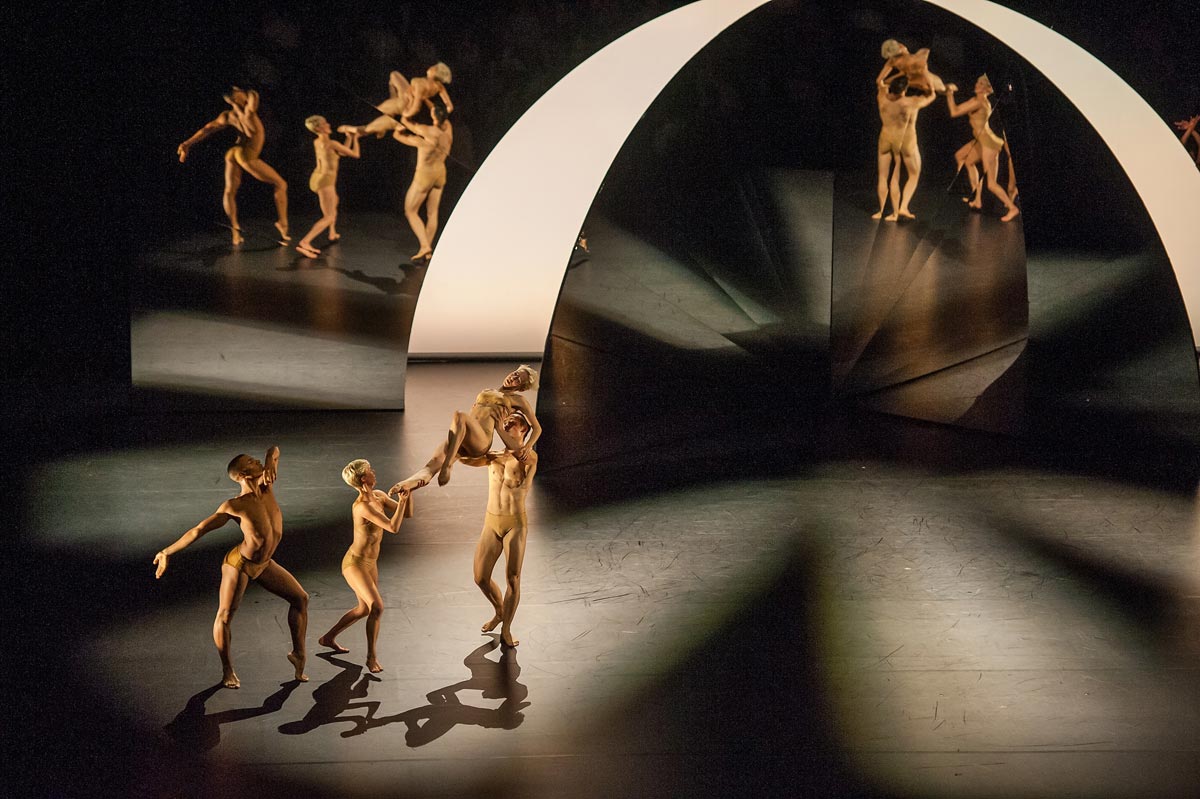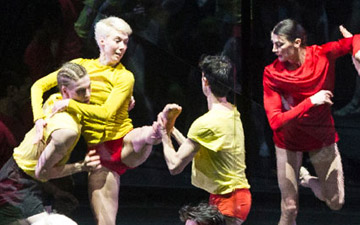
© Stephanie Berger. (Click image for larger version)
Wayne McGregor | Random Dance & Paris Opera Ballet
Tree of Codes
New York, Park Avenue Armory
17 September 2015
www.randomdance.org
www.armoryonpark.org
Son et Lumière
The Park Avenue Armory is a gargantuan space, encompassing a whole city block. Anything that happens there feels like an event, perhaps in part because the place is still haunted by the excitement of the final Merce Cunningham Dance Company performances at the end of 2011. The audience’s entry into the drill hall before the start of Tree of Codes, the new collaboration between Wayne McGregor, Olafur Eliasson, and the electronic music producer and composer, Jamie XX, is one of the evening’s high points. (Tree of Codes was adapted for the space after premièring at the Manchester International Festival last year.) Beyond the raised stage, the spectator faces a wall of seats, rising up and up as far as the eye can see. On either side of the stage – an elevated platform – lights create overlapping, colored shadows on the walls; people stop and pose, take pictures. There’s a carnival feel – everyone’s part of the show.
Then the lights go down and the real show begins. The beginning is auspicious. In total darkness, to rhythmic clapping patterns and something that sounds like a dulcimer, tiny lights dart across the stage – dancers fitted with lights at every articulation: feet, knees, hips, shoulders, elbows. As they twist and curl, they look like moving constellations, absences framed in light. It is an image of great poetry, even mystery.

© Stephanie Berger. (Click image for larger version)
If only the spell lasted. Instead, as the lighting effects multiply and the dancers’ energy unspools in a relentless stream, Tree of Codes spirals into a kind of spectacular monotony. McGregor, the choreographer, is a master of accumulation; bodies churn and twist and heave and flick – or are dragged or flung – but nothing leads or builds toward anything else. In the end, there is only so much a body can do before you begin to wonder what it’s all for. (The dancers, who include six members of the Paris Opera Ballet and nine from McGregor’s own company, are extraordinary, tireless, heroic.)
Nor does the choreographer seem to derive much impetus from Jamie XX’s music, which tends toward meditative ambient sounds, throbbing beats, and the odd melancholy passage for the piano. (There are a few words, too, including a phrase that returns several times: “Are we two, and we don’t know what to do.” A question? A complaint?) Mostly, the movement and music coexist in a kind of amicable détente; only in one section do they seem to lock onto each other; immediately, one’s attention snaps into focus. That section also happens to contain some of the most distinctive movement in Tree, lopes and crawls and swatting limbs, as if the dancers were members of into a hitherto undiscovered species.
The design, by the Icelandic-Danish artist Olafur Eliasson, is full of mirrors and portals, colored lights and tinted screens that create enclosed and interconnecting spaces for the dancers. With its layers and portals, the stage environment alludes to the original inspiration for Tree of Codes: Safran Foer’s eponymous novel and so-called “sculptural object” from 2010. To create his novel, Foer cut out words from another book, Street of Crocodiles, a volume of stories by the Polish writer, Bruno Schulz. (A case of creation by deletion.) The resulting tome was punctuated by neat little holes, which created a lattice of geometric shapes, echoed here by the revolving circles, portals and passageways of the stage. (The Armory program also features artfully-placed cutouts.)

© Stephanie Berger. (Click image for larger version)
Foer’s influence is more difficult to discern in the other elements of the collaboration, not that it matters much. What stands out, instead, amid the roiling activity is the presence of one particular dancer, the Paris Opéra étoile, Marie-Agnès Gillot. With her extraordinary physique – long-limbed, tall, and achingly lean – and inscrutable expression she imposes herself even, or especially, when she is still. One particular curve of her long arms, held in third position, is etched in my mind as I write this; at the time it seemed to contain some fundamental truth about the universe. Gillot has that rare ability – like Wendy Whelan, though without the sweetness – to cut away all excess, presenting each shape and transition as an ineluctable fact. She doesn’t emote, she doesn’t exaggerate, she just is.
Gillot returns three or four times, in three different costumes, each time more striking; in those passages, McGregor’s movement seems more spare, more accented and, inevitably, more interesting. With her startling presence, Gillot manages to supply Tree of Codes with the sense of purpose it otherwise lacks.

















I thought TOC would never end. BORING. Utterly pointless.
Gillot is so skinny it’s hard to think of much else when I see her dance.
The sung refrain is actually a sample from “So Much In Love”, and goes like this: “So in love are we two, that we don’t know what to do”. Not nearly a complaint or question, but an expression of overwhelming new love, something that was emphasized rather beautifully by the movements here. I think the use of Jamie xx to score this was not by chance as his creations pull from a huge swath of popular music to combine them into something rather disparate from their original meaning (fitting the “Tree” aesthetic), and I felt the show was more meditative on emotions rather than driving at a point per se.